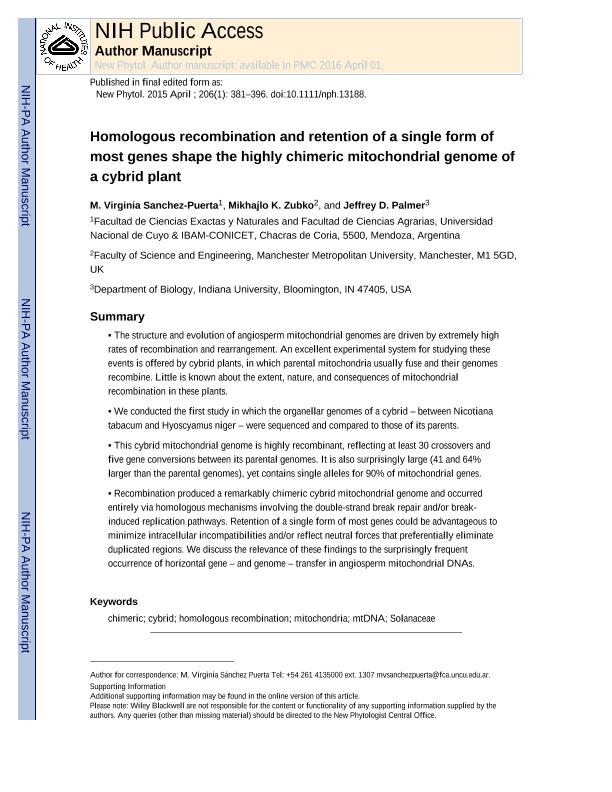Mostrar el registro sencillo del ítem
dc.contributor.author
Sánchez Puerta, María Virginia

dc.contributor.author
Zubko, Mikhajlo K.
dc.contributor.author
Palmer, Jeffrey D.
dc.date.available
2017-08-15T12:12:29Z
dc.date.issued
2015-04-28
dc.identifier.citation
Sánchez Puerta, María Virginia; Zubko, Mikhajlo K.; Palmer, Jeffrey D.; Homologous recombination and retention of a single form of most genes shape the highly chimeric mitochondrial genome of a cybrid plant; Wiley; New Phytologist; 206; 1; 28-4-2015; 381-396
dc.identifier.issn
0028-646X
dc.identifier.uri
http://hdl.handle.net/11336/22403
dc.description.abstract
The structure and evolution of angiosperm mitochondrial genomes are driven by extremely high rates of recombination and rearrangement. An excellent experimental system for studying these events is offered by cybrid plants, in which parental mitochondria usually fuse and their genomes recombine. Little is known about the extent, nature and consequences of mitochondrial recombination in these plants. We conducted the first study in which the organellar genomes of a cybrid – between Nicotiana tabacum and Hyoscyamus niger – were sequenced and compared to those of its parents. This cybrid mitochondrial genome is highly recombinant, reflecting at least 30 crossovers and five gene conversions between its parental genomes. It is also surprisingly large (41% and 64% larger than the parental genomes), yet contains single alleles for 90% of mitochondrial genes. Recombination produced a remarkably chimeric cybrid mitochondrial genome and occurred entirely via homologous mechanisms involving the double-strand break repair and/or break-induced replication pathways. Retention of a single form of most genes could be advantageous to minimize intracellular incompatibilities and/or reflect neutral forces that preferentially eliminate duplicated regions. We discuss the relevance of these findings to the surprisingly frequent occurrence of horizontal gene – and genome – transfer in angiosperm mitochondrial DNAs.
dc.format
application/pdf
dc.language.iso
eng
dc.publisher
Wiley

dc.rights
info:eu-repo/semantics/openAccess
dc.rights.uri
https://creativecommons.org/licenses/by-nc-sa/2.5/ar/
dc.subject
Homologous Recombination
dc.subject
Cybrid
dc.subject
Evolution
dc.subject
Solanaceae
dc.subject
Chimeric
dc.subject
Mitochondria
dc.subject
Mtdna
dc.subject.classification
Bioquímica y Biología Molecular

dc.subject.classification
Ciencias Biológicas

dc.subject.classification
CIENCIAS NATURALES Y EXACTAS

dc.title
Homologous recombination and retention of a single form of most genes shape the highly chimeric mitochondrial genome of a cybrid plant
dc.type
info:eu-repo/semantics/article
dc.type
info:ar-repo/semantics/artículo
dc.type
info:eu-repo/semantics/publishedVersion
dc.date.updated
2017-07-13T17:53:30Z
dc.journal.volume
206
dc.journal.number
1
dc.journal.pagination
381-396
dc.journal.pais
Estados Unidos

dc.journal.ciudad
Hoboken
dc.description.fil
Fil: Sánchez Puerta, María Virginia. Consejo Nacional de Investigaciones Científicas y Técnicas. Centro Científico Tecnológico Conicet - Mendoza. Instituto de Biología Agrícola de Mendoza. Universidad Nacional de Cuyo. Facultad de Ciencias Agrarias. Instituto de Biología Agrícola de Mendoza; Argentina. Universidad Nacional de Cuyo. Facultad de Ciencias Agrarias; Argentina. Universidad Nacional de Cuyo. Facultad de Ciencias Exactas y Naturales; Argentina
dc.description.fil
Fil: Zubko, Mikhajlo K.. Manchester Metropolitan University. Faculty of Science and Engineering ; Reino Unido
dc.description.fil
Fil: Palmer, Jeffrey D.. Indiana University. Department of Biology; Estados Unidos
dc.journal.title
New Phytologist

dc.relation.alternativeid
info:eu-repo/semantics/altIdentifier/url/http://onlinelibrary.wiley.com/doi/10.1111/nph.13188/abstract
dc.relation.alternativeid
info:eu-repo/semantics/altIdentifier/doi/http://dx.doi.org/10.1111/nph.13188
dc.relation.alternativeid
info:eu-repo/semantics/altIdentifier/url/https://www.ncbi.nlm.nih.gov/pmc/articles/PMC4342287/
Archivos asociados
